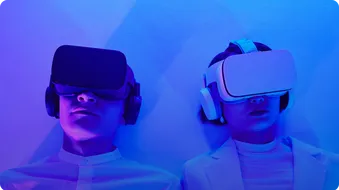How Augmented Reality Can Improve The Customer Experience
Facing increasing competition and pricing pressure, businesses often have only one decisive distinguishing feature left: a better customer experience. Augmented Reality (AR) offers companies and brands new ways to significantly enhance the customer experience.

From virtual try-ons and product launches to AR-led tours through shops or hotels, the possibilities are vast. AR already provides exciting opportunities to create a unique customer experience today, and with the further development of this technology, it will be increasingly integrated into our everyday lives.
What is Augmented Reality?
AR is a technology that integrates digital information into the physical world. It enables users to see and interact with virtual objects in the real world using mobile devices such as smartphones, tablets, and specialised AR glasses.
Examples of Augmented Reality Applications
AR offers businesses and brands new ways to communicate marketing messages to their target audiences. Here are some examples of how AR can improve the customer experience:
Virtual Try-Ons & Product Tests:
Customers can virtually try on clothing or test furniture in their living spaces before making a purchase decision. This strengthens confidence in the buying process, as customers can see whether the sofa fits with their existing furnishings before ordering it.
Product Launch:
Instruction manuals often end up unread in a drawer. AR can help introduce customers to new products and features by displaying digital information directly on the product that explains its functions and applications. This can significantly reduce buyer's remorse and increase customer loyalty.
Customer Support:
When there are problems with a product, customer service or support must help. For many companies, this is a significant cost factor. From the customer's perspective, how quickly and efficiently the problem is solved is crucial. It can be frustrating if many emails have to be written back and forth or if one must endure 20 minutes of music on hold. AR can help solve problems with a product efficiently and reduce the costs associated with customer service or support. Technicians in fields such as machinery and plants can use AR to become independent problem solvers on-site at customers'.
AR-Led Tours:
AR can guide customers through retail stores or hotels and provide an interactive experience. Customers using AR applications on their smartphones or AR glasses can explore different products or spaces and thereby increase their connection to the brand. This technology is already being used by some retailers and hotels to offer their customers an interactive experience.
Interactive AR Content on Packaging or Displays:
AR technology can also be used on packaging or displays to offer customers interactive content. By using their smartphones or AR glasses, customers can access additional information about products or services. The merging of physical and digital content, also known as "Phygital", is becoming increasingly popular. This allows almost any physical product to be enriched with digital content, opening up new possibilities for interactive and data-driven marketing strategies.
Personalised Product Recommendations:
With AR glasses, sales staff can display customer data such as purchase history or demographic characteristics during sales conversations and give personalised product recommendations.
Conclusion and Outlook
Augmented Reality is an exciting technology that can improve the customer experience across various industries. With the launch of advanced AR devices that can project virtual content into the real world, this technology has reached a new peak. These devices offer features such as voice control, facial recognition, and eye tracking, which can further enhance the customer experience. Although there are still challenges such as privacy concerns, the continuous development of AR technology will bring exciting innovations and improvements in the customer experience in the future.


